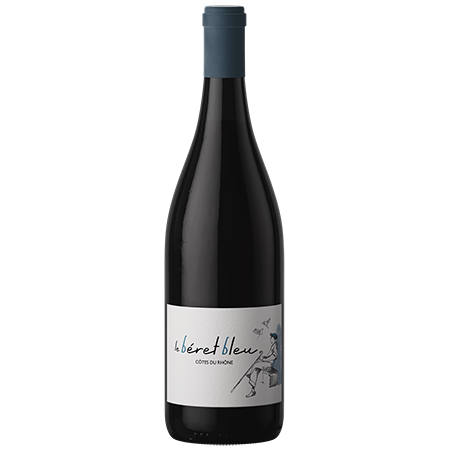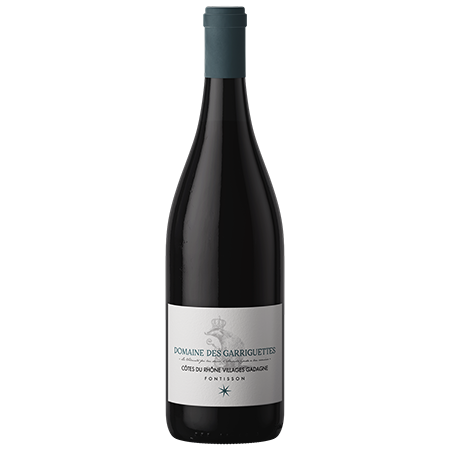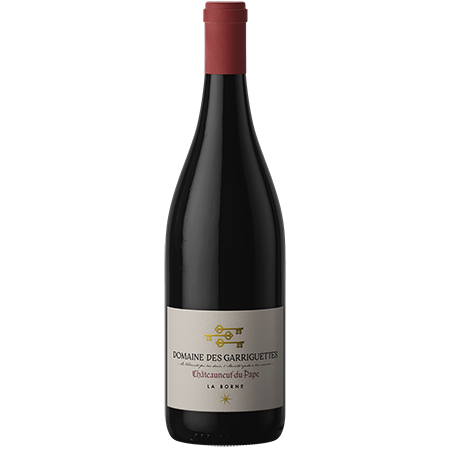Domaine des Garriguettes
In France’s Southern Rhône Valley, just 12 kilometers east of Avignon, lies Domaine des Garriguettes…
a four-generation family winery, in the village of Châteauneuf de Gadagne. Sébastien Clément is a young vigneron handcrafting innovative and fresh expressions that honor the traditions of his Provençal village. The domaine utilizes strictly natural and regenerative farming practices and produces Demeter-certified biodynamic wines from old vines. Made without the use of chemicals or additives, Garriguettes offers wines of exceptional freshness, elegance, and ultimate drinkability; a revelation in southern France.
Domaine des Garriguettes benefits from the idyllic Mediterranean climate and exposure to the warm southern Mistral wind, both of which provide optimal conditions for organic and biodynamic viticulture. Old olive trees cohabitate among cinsault, grenache, mourvèdre, and syrah vines on the property, many of which have been in the family for generations. Garriguettes was the first vineyard in their village to embrace organic agriculture and continues to be a natural winemaking leader in the region.
Châteauneuf de Gadagne is a charming Provençal village rooted in local traditions, with a long, illustrious history as a wine-producing village, one of the oldest in France — dating back at least to the Phoenician culture. The village is located in an ideal position on top of a hill overlooking the Rhône Valley on the one side and Mont Ventoux on the other. The castle and its ramparts, which were the seat of power of the Duchy of Gadagne in 1669, can still be seen at the highest point of the hill. Sepia-toned medieval cobbled streets, ancient monuments, and a soundtrack of cicadas playing in the background of the golden countryside all contribute to an easy-living atmosphere and a feeling of timelessness.
The Gadagne Castle used to have its own vineyards in the place known as “Les Garriguettes”, which are now cultivated by Domaine des Garriguettes, and the source of its name. The region remained under papal rule until becoming part of France in 1791. This legacy can be seen in the massive Palais des Papes (Popes’ Palace) in the city center of Avignon, the historic destination for the consumption of the Gadagne village wines.
Châteauneuf de Gadagne is very important to Provençal culture and the ancient Occitan language. The jewel of the village is Château de Fontségugne, where in 1854, Frédéric Mistral began the revival movement of Occitan language and literature, called the Félibrige, with a gathering of his fellow prominent Provençal poets, to promote the language of “Oc”. The word “félibrige” is derived from félibre, a Provençal word meaning pupil or follower. Provençal is a dialect of the Occitan language, but confusingly, the name is sometimes used as a synonym for Occitan. Le Félibrige is an organization focused on protecting and promoting Occitan language and culture, fighting for recognition of cultural diversity both within France and across the wider world. This movement was instrumental in preserving the culture and language for future generations. Intrinsically tied to their homeland, Sébastien and Domaine des Garriguettes approach their mission with the same motivation: to translate and propagate their region’s culture into the next generation.
The Gadagne village story is truly the tale of an underdog – one of the great, unique terroirs of the region that has gone unheralded for many years due to political feuds with the much more powerful Châteauneuf-du-Pape appellation. Gadagne has been under the AOP appellation Côtes du Rhône Villages Gadagne (Protected Designation of Origin Gadagne) since the 2012 vintage, Côte du Rhône Villages since 1997, and Côtes du Rhône since 1937. Due to restrictions from the powerful Châteauneuf-du-Pape appellation (which they also produce), Domaine des Garriguettes are restricted from using the full name of the village, Châteauneuf de Gadagne on the label. The two appellations share almost identical characteristics, from climate to the famous galets roulés soil, of which Châteauneuf-de-Gadagne has approximately 120 hectares of all three types: rouge, blanc, and orange.
Gadagne was originally a woodcutter’s village whose Châteauneuf was built in 1150. Châteauneuf du Pape at that stage was known as Châteauneuf Calcernier, after its limestone quarry. It had been a ‘Châteauneuf’ (castrum novum) since 1094 or earlier, though the actual ‘Châteauneuf du Pape’, the source of the appellation name today, was only begun in 1317. The growers of Gadagne have held the position that since their castle is actually older than the one in Châteauneuf du Pape, they have the historic right to the name Châteauneuf de Gadagne.
In the vineyards of Domaine des Garriguettes, one can clearly see the old boundary stones marking the limits of the papal domains with the famous crest of the papacy: the papal tiara placed above the keys of St. Peter. In the end, the growers of Gadagne realized that the dispute over the Châteauneuf name would prevent them ever achieving named-village status, so they capitulated and Gadagne became one of the 18 named villages in 2012.
Raised in the family winery, Sébastien inherited his passion for wine, along with hands-on experience at a very early age, from his grandfather Jean Clément, and his father, Jean Louis. Subsequently, Sébastien left the region to work at other wineries for a few years, gaining valuable winemaking experience along the way. Sébastien and Domaine des Garriguettes have two guiding philosophies: a deep respect for promoting their family heritage and cultural traditions into the future, and a sensitivity and sense of responsibility for their contribution to the equilibrium of their ecosystem. The blending of traditional and natural vinification methods demonstrates their constant quest to produce high-quality wines with progressive regenerative and biodynamic farming methods, as well as natural winemaking techniques. All of Garriguettes’ estate vineyards are farmed certified organic (Ecocert) and certified biodynamic (Demeter), since the 2010 vintage; however, Sébastien’s father, John Louis, also worked without chemical intervention.
On 50 hectares of land, Domaine des Garriguettes has 22 hectares of vines and two hectares of olive trees planted in a pastoral, polyculture setting. They utilize cover crops for soil health and to reduce heat stress in the vineyards, among other benefits. Two full-time and five part-time employees assist the family in the vineyards during peak season.
In the cellar, Sébastien works in an intuitive manner with the least amount of intervention possible. Every vineyard and cuvée is handled individually; the only formula at the winery is excellence. Indigenous yeasts are used for alcoholic fermentation for the entirety of the cuvées, and malolactic fermentations are spontaneous and never rushed. Added sulfur dioxide is not present in the Le Béret Bleu and Châteauneuf-du-Pape, and only minimally in the other wines. There is no dogma about sulfur, other than Sébastien endeavors to make the very best, most expressive wine possible, with or without sulfur.
The domaine produces a range of wines, including blanc, rosé, several Côtes du Rhône: Le Béret Bleu (a fresh, glou-glou 100% cinsault sans soufre cuvée dedicated to his grandfather, Jean Clément), Cuvée Tradition (50% grenache / 50% syrah), two single-vineyard, single-variety Côtes du Rhône Villages Gadagne: L’Amista (100% grenache) and Fontisson (100% syrah), and finally, a single-vineyard Châteauneuf-du-Pape ‘La Borne’ (grenache and mourvèdre)
The production of the winery leads off with Le Béret Bleu Côtes du Rhône Rouge, an unbelievably juicy and fresh small-production wine from 100% cinsault vinified in a cement tank. The label features an illustration of Sébastien’s grandfather, Jean Clément, as a tribute to the easy-going nature and Provençal spirit of the wines his grandfather made. Without a doubt, Le Béret Bleu is one of the most surprisingly delicious glou-glou wines from the Côtes du Rhône discipline. The wine is just plain fun to drink and we just cannot get enough of this small-production wonder.
Domaine des Garriguettes Cuvée Tradition Côtes du Rhône Rouge is the primary production of the winery, produced with 50% grenache and varying proportions of syrah and mourvèdre. The plots of land producing the Côtes du Rhône Rouge Tradition are located at the center of the Châteauneuf de Gadagne plateau in red clay soil, covered with pebbles, and abundantly ventilated by the Mistral wind. Each of the varietals are harvested and vinified separately, then assembled and aged in concrete. The uniqueness and success of their primary cuvée is a testament to the work of Sébastien and his family. Their high quality standards are evident in the glass, making it one of the top expressions of the region.
The pride of the Garriguettes estate are their old grenache vineyards, which are around 60 years old on average. One of their most special wines is a single-vineyard bottling from their 1.6 hectare ‘L’Amista’ vineyard planted in 1954 with old clones of goblet-trained grenache at 115m. The plot does not suffer from heat stress and is usually their last plot harvested by hand, by friends and family only, hence the name, which translates as “friendship.” L’Amista is an incredibly aromatic, lithe, and soulful grenache, a truly expressive and exciting wine from an historic vineyard. L’Amista is undoubtedly among the world’s great expressions of the grenache variety.
The other side of the coin is their top expression of syrah, called ‘Fontisson’ after the French phrase La Fontaine des Blaireaux, or “The Fountain of Badgers,” which is the name for a particularly cool, north-facing parcel (1.3 hectares) containing a freshwater source, surrounded by hedges that draw badgers to the vineyard for the cooler temperatures and water. There is a practical application to this true story, as it proves to be an ideal terroir for syrah, which needs a cooler climate in the southern Rhône to retain acidity and balance. Old syrah clones were planted here in 1972, yielding an unbelievable expression of the grape that displays all of the elegance, freshness, and depth one associates with Hermitage, yet with an unmistakable southern Rhône signature. Fontisson is truly something special and just may be the finest cuvée of 100% syrah in the region.
The domaine also has one 0.4 hectare parcel in Châteauneuf-du-Pape Called ‘La Borne’ that they work by hand and by horse. The vineyard is located at the south of Châteauneuf-du-Pape, in a cooler zone, at 80m with the typical galets roulés soil. The goblet-trained vineyard was planted in 1964 and is vinified 100% whole cluster and produced without added sulfites. La Borne is a truly unique and new expression in Châteauneuf-du-Pape, with its light frame, bright and juicy fruit, and irrepressible energy. It is not an overstatement to say that in La Borne, Domaine des Garriguettes gives us the blueprint for a new style of Châteauneuf-du-Pape, one that does not rely on over-ripeness or the excessive use of oak barrels to provoke interest. On the contrary, La Borne displays the perfume, elegance, and grace associated with some of the most celebrated examples of the region from wineries like Château Rayas and Charvin. The only downside is the tiny production of the vineyard, which yields an average of just 1800 bottles per vintage. A true, singular gem worth seeking out.
Sébastien Clément is a friendly, highly energetic, and passionate ambassador for his culture, which guides him in all of his work at Domaine des Garriguettes. You will often find him beaming with a smile, proudly wearing the béret bleu, blue cap, of his grandfather — a symbol of the working class of his region. It is important to understand that Sébastien’s motivation is not solely to produce wine; rather, he seeks to propagate a way of living in harmony with his native region, bettering it along the way. There is a distinct positive energy and momentum carrying his work that is both captivating and inspiring, and for which we are honored to bring his message to the United States.




